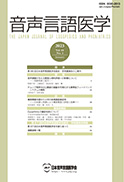
- Issue 4 Pages 237-
- Issue 3 Pages 143-
- Issue 2 Pages 75-
- Issue 1 Pages 1-
- |<
- <
- 1
- >
- >|
-
—Relationships with Cognitive and Play Development at Home—Tadashi Koyama2023 Volume 64 Issue 4 Pages 237-243
Published: 2023
Released on J-STAGE: September 29, 2023
JOURNAL RESTRICTED ACCESSIn children with typical development, early acquisition of words that represent time, position, or place is known to be related to the acquisition of action words. It is also thought to be related to the development of cognition and play in daily life, but there are few studies on this point. In this study, the author examined relationships between the acquisition of words representing time, position, and place and the development of cognition and play in the home in children with typical development, focusing on those 2 to 3 years of age. The subjects were children who are enrolled in nursery schools and their parents. The parents were asked to complete the Japanese MacArthur Communicative Development Inventory (CDI) and a questionnaire on cognitive and play development at home. The results of correlation analysis between expressive vocabulary scores that represent action words, time, position, and place in the CDI's "Words and Grammar" and various variables of cognition and play at home from 23 to 36 months of age suggested that the acquisition of words to describe time, position, and place is related to acquisition of action words, as well as to "representation of human actions," "compositional play with objects," and "spatial understanding" as seen in child development of cognition and play at home.
View full abstractDownload PDF (323K) -
Shogo Mato, Itaru Watanabe, Makoto Miyamoto, Hideki Nakagawa, Keiko Is ...2023 Volume 64 Issue 4 Pages 244-251
Published: 2023
Released on J-STAGE: September 29, 2023
JOURNAL RESTRICTED ACCESSWhile speech and language therapy (SLT) is recommended as behavioral therapy for chronic cough, the therapeutic impact of SLT in treating patients with this disease has not yet been reported in Japan. In this study, we performed multidimensional analysis on the therapeutic impact of SLT against chronic cough. Nine patients who underwent SLT for chronic cough with symptoms persisting more than 8 weeks after onset between January 2019 and July 2020 were incorporated into this study. Their symptoms were resistant against standard cough treatments administered by respiratory physicians and/or otorhinolaryngologists. The protocol of SLT to treat chronic cough consisted of education on coughing, laryngeal hygiene, cough control, and psychoeducational counseling. This regimen was performed 4 times in 8 weeks on each patient. Significant improvements in the Leicester Cough Questionnaire (LCQ), Japanese version of Newcastle Laryngeal Hypersensitivity Questionnaire (J-NLHQ), G score, maximum phonation time (MPT), and Voice Handicap Index (VHI) were observed after SLT. Improvements in LCQ and J-NLHQ were observed in 77.8% and 66.7% of patients, respectively. Significant improvements in GERD-Q were not observed after SLT; however, the scale of effect was considerable. Our study suggested that improvement of various laryngeal functions by SLT might be responsible for successful suppression of chronic cough.
View full abstractDownload PDF (394K)
-
Makoto Miyamoto, Koichiro Saito2023 Volume 64 Issue 4 Pages 252-256
Published: 2023
Released on J-STAGE: September 29, 2023
JOURNAL RESTRICTED ACCESSDiplophonia is defined as a voice in which different pitches are audibly heard at the same time. Psychoacoustic evaluation is the principal method for evaluating diplophonia; however, the asymmetric vocal fold vibrations during phonation can be observed by laryngeal stroboscopy and high-speed digital camera.
In this case, we experienced a child with hoarseness from birth and audible diplophonia. The epiglottic portions tipped forward and covered the glottis when the child cried. We thought the diplophonia in this case was caused by the two sources of the voice: the glottis and epiglottis. To evaluate the diplophonia, we used an acoustic analyzer (Multi-Dimensional Voice Program) to analyze the crying voice and confirmed the two peaks of fundamental frequencies.
This was a very rare case of diplophonia from birth, and we found that acoustic analysis is just as useful for evaluating hoarseness in a newborn as psychoacoustic evaluation.View full abstractDownload PDF (1306K)
- |<
- <
- 1
- >
- >|